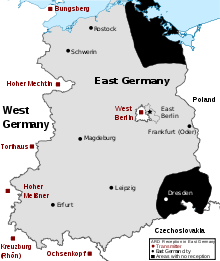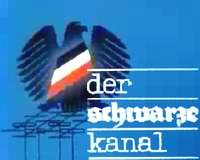Der schwarze Kanal
Der schwarze Kanal ("The Black Channel") was a series of political propaganda programmes broadcast weekly between 1960 and 1989 by East German television Deutscher Fernsehfunk. Each edition was made up of recorded extracts from recent West German television programmes re-edited to include a Communist commentary.[1]


The programme was hosted by Karl-Eduard von Schnitzler and began on 21 March 1960. The name "Black Channel" is a play on words: in the German language "black channel" is a euphemism by plumbers for a sewer (compare English soil pipe). The name and the concept of the programme were originally a reaction to a West German programme named Die rote Optik ("The red viewpoint") authored by journalist Thilo Koch, which ran between 1958 and 1960 and analysed East German television clips.[2] Although the programme was primarily intended for domestic (East German) consumption, the programme makers (at least in the early days) hoped that those in the West who could receive DFF would also watch.[2]
The geography of the divided Germany meant that West German television signals (particularly ARD) could be received fairly readily in most of East Germany. Areas with no reception (black) such as parts of Eastern Saxony around Dresden were jokingly referred to as "Valley of the Clueless" (Tal der Ahnungslosen).[3] West German acronyms ZDF and ARD accounted for Zentrales Deutsches Fernsehen Außer Rügen und Dresden (Central German TV except Rügen and Dresden). Whilst radio signals from international broadcasters like the BBC and the American-backed local station RIAS in West Berlin could be jammed, it was diplomatically and technically awkward to block West German television as it would have been impossible to do so (with any degree of effectiveness) without affecting reception in parts of West Germany as well which (apart from being outlawed by treaty) in turn could have prompted the West Germans to retaliate against Eastern broadcasts.[1]
The solution, as seen by DFF, was to record items from the ARD and ZDF that were unwelcome in the East or provided a different spin on a news story and replay the items on the main DFF1 channel with a commentary "explaining" what was really "meant" by the item, or how the item was "untrue" or "flawed".[1]
The 20-minute programme was usually scheduled for transmission at around 21.30 on Monday evenings, before or after a film or some other popular item[2] in the hope that viewers tuning in early to catch the film would see the programme.[2] According to some sources official surveys gave a programme a 5% audience figure.[2]
The programme ceased broadcasting on 30 October 1989, just ahead of the opening of the borders with the west on 9 November, at which point the East German television service declared itself "free of government interference"[4] before merging less than a year later with its formerly rival West German television networks as a result of German reunification.
The programme was featured in the 1999 movie, Sonnenallee and the 2019 TV series Deutschland 86.
See also
- Aktuelle Kamera
- Karl-Eduard von Schnitzler
- Eastern Bloc information dissemination
References
- Hancock, Dafydd (2001-01-01). "Fade to black". Intertel from Transdiffusion. Retrieved 2015-09-28.
- Grape, Andreas (September 2000). "Die digitalisierten Sendemanuskripte - Der schwarze Kanal" (in German). Deutsches Rundfunkarchiv. Retrieved 2007-05-12.
With the transmission title black channel was meant also the west television, by itself the "dirt and Unrat, which would have to actually flow on the sewage farms", thus moderator of Schnitzler, into the dwellings of the spectators poured. Karl Eduard von Schnitzler, who coined/shaped the transmission by editorship and presentation as Chefkommentator of the GDR television considerably, wanted to serve here "to a certain extent as purification plant"
- Mitchener, Brandon (1994-11-09). "East Germany Struggles, 5 Years After Wall Fell". International Herald Tribune. Retrieved 2007-05-12.
- Schnitzler, Karl-Eduard von (1992). Der Rote Kanal (in German). Hamburg: Nautilus. ISBN 3-89401-211-0.